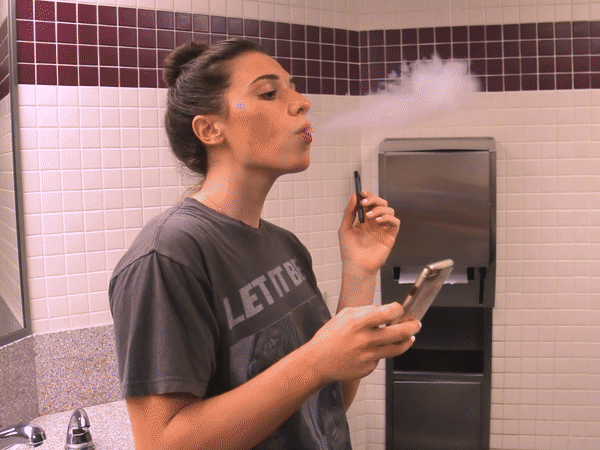
Schools have been removing bathroom doors, posting bathroom monitors, and even closing bathrooms in their struggles to handle the surging popularity of vaping among middle school and high school students. That has translated into steady business for a U.S. company offering AI-assisted school surveillance capable of alerting teachers and administrators to suspected vaping or bullying in bathrooms.
Soter Technologies originally developed its Fly Sense device with bullying detection in mind. But schools began asking the company about whether it could also help monitor the rise of vaping—also known as Juuling because of the popular Juul vape pens—among students. In response, the company made Fly Sense into a cloud-connected sensor capable of detecting both the telltale signatures of vaping and elevated sound levels that might indicate fighting or bullying.
“Schools typically install the system and see a spike of vaping incidents in the first two weeks,” says Derek Peterson, CEO of Soter Technologies. “And then as they continue to go through their school policy plan of reprimanding the students, they start to see vaping incidents in those locations tail off.”
More than 200 schools in the United States and Canada have already installed Fly Sense, including schools across at least 23 states. Four school districts in Florida and California have gone all out to become “full-deployment districts” using the Fly Sense system. Other schools are quickly catching on. The company shipped out more than 400 Fly Sense devices in the past month, Peterson says.
The Fly Sense device uses machine learning AI that has been trained to detect the water vapor signature coming from vaping pens, e-cigarettes and other vaping paraphernalia. Most vaping devices popular among students consist of a flavored vaping liquid—sometimes called “vape juice”—that includes a hefty dose of addictive nicotine. Once installed, each Fly Sense device can learn the baseline patterns of water vapor in a given bathroom so that the system’s thresholds for what counts as an anomaly can be adjusted accordingly.
The constant evolution of vaping has created a technological arms race of sorts, and has prompted Soter Technologies to continuously update its classification library for vaping signatures. For example, the very first version of Fly Sense could not detect the vaping signature from Juul vape pens that have become especially popular among students.
Much has changed since that time. In August, the company announced version 2.5 of its Fly Sense device and hopes to roll out version 3.0 in spring 2019. Future versions of Fly Sense could potentially even perform more sophisticated chemical analyses that sniff out the difference between a vaping pen signature with nicotine versus tetrahydrocannabinol (THC), the active chemical compound found in cannabis.
Soter Technologies claims that the Fly Sense system generally achieves a vaping detection accuracy of between 70 and 80 percent, and that the system has helped schools achieve a 70 percent decrease, on average, in vaping incidents at locations where the system is installed.

But AI-boosted bathroom surveillance still needs plenty of human help. Whenever a suspected vaping incident triggers an investigation, schools can confirm whether or not the Fly Sense alert had correctly identified vaping or was a false positive case. That feedback helps train the system to become progressively more accurate over time.
Schools that install Fly Sense in their bathrooms get access to Soter Technologies’ automated cloud platform that tracks the data being collected by Fly Sense and manages the alert system. School administrators can even manage the system so that only specific teachers will receive alerts on their phones from certain Fly Sense devices.
The dual-purpose mission of Fly Sense means that it also has the capability to keep watch for bullying or fighting by detecting sound levels based on decibels. If the sounds in a bathroom or locker room exceed a certain sound threshold—something that can be adjusted by school administrators—that can trigger a similar mobile alert that could prompt a principal or teacher to go investigate. At the same time, the system’s lack of natural language recognition or identification of voices belonging to particular individuals is meant to avoid student privacy concerns.
“The original intent of the product was to take care of the bullying aspect,” Peterson says. “That comes from my own personal history of being five-foot-one in high school and being bullied: I have a personal stake in helping rid the world of bullies.”
Whatever the use, Fly Sense seems to appeal to schools seeking to tackle different but similarly troubling national trends. Between one-quarter and one-third of U.S. students report being bullied at school. It’s an issue that likely affects millions of students each year. On the vaping side, the 2017 National Youth Tobacco Survey found that approximately 2.1 million students had used e-cigarettes.
The vaping trend in particular has attracted new customers for Fly Sense from the corporate world. Many major corporations prohibit vaping on company grounds and seem as interested as schools in an automated solution such as that being offered by Soter Technologies, Peterson says. But given the meteoric rise of vaping among students in recent years, schools remain a primary market for high-tech solutions as long as they fight to deter vaping behavior on school grounds.
“We probably will have about 20 inquiries a day from schools looking to buy the product,” Peterson says.
























